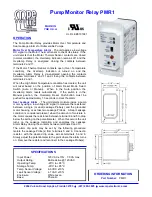
EMR-4000
IM02602009E
RTD Protection Module
Elements:
RTD
General – Principle Use
The Resistance-based Temperature Detector (RTD) Protection Module uses
temperature data that are provided by Eaton's Universal Resistance-based
Temperature Detector (URTD) module (please refer to the URTD Module
section) or Eaton's Universal Resistance-based Temperature Detector II
(URTDII) module (please refer to the URTDII Module section).
If voting trip is required, please map the output used for tripping purposes:
"RTD. Voting Trip Grp 1" or "RTD.Voting Trip Grp 2"
The protective device provides tripping and alarming functions based on the direct temperature measurements read
from Eaton’s (URTD) device that has 11 temperature sensor channels or Eaton’s (URTDII) device that has 11 or 12
temperature sensor channels. Each channel will have one trip function without an intended delay and one alarm
function with a delay.
•The “trip” function has only a threshold setting.
•Each individual »A
larm Function« will have a threshold setting range, and can be individually enabled or disabled.
Since the temperature cannot change instantaneously (which is a way that temperature differs from current), the “delay”
is essentially built in to the function due to the fact that the temperature will take some time to increase from room
temperature to the “trip threshold” level.
•The dropout ratio for both trip and alarm is 0.99.
•The temperature rise is limited by the RTD driver.
•The entire function can be turned off or on, or individual channels can be turned off or on.
www.eaton.com
697
















































